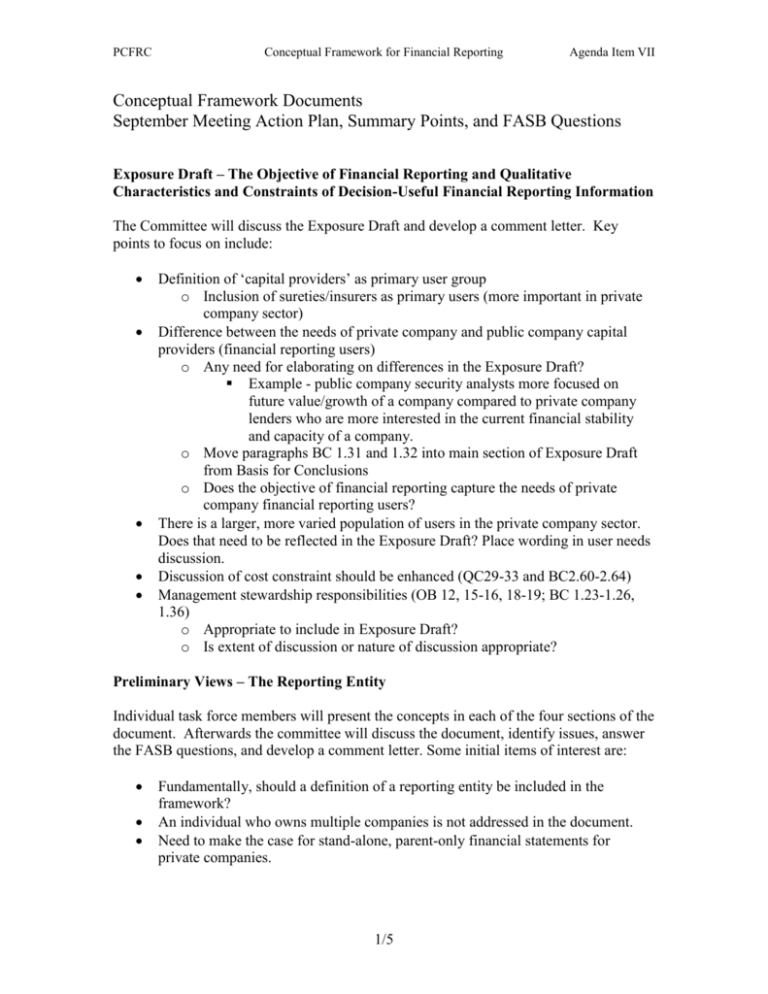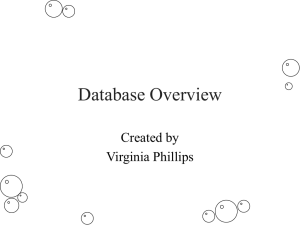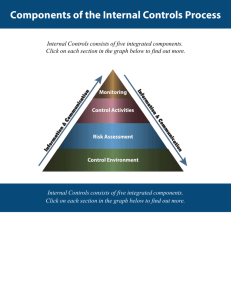Conceptual Framework - Private Company Financial Reporting
advertisement

PCFRC Conceptual Framework for Financial Reporting Agenda Item VII Conceptual Framework Documents September Meeting Action Plan, Summary Points, and FASB Questions Exposure Draft – The Objective of Financial Reporting and Qualitative Characteristics and Constraints of Decision-Useful Financial Reporting Information The Committee will discuss the Exposure Draft and develop a comment letter. Key points to focus on include: Definition of ‘capital providers’ as primary user group o Inclusion of sureties/insurers as primary users (more important in private company sector) Difference between the needs of private company and public company capital providers (financial reporting users) o Any need for elaborating on differences in the Exposure Draft? Example - public company security analysts more focused on future value/growth of a company compared to private company lenders who are more interested in the current financial stability and capacity of a company. o Move paragraphs BC 1.31 and 1.32 into main section of Exposure Draft from Basis for Conclusions o Does the objective of financial reporting capture the needs of private company financial reporting users? There is a larger, more varied population of users in the private company sector. Does that need to be reflected in the Exposure Draft? Place wording in user needs discussion. Discussion of cost constraint should be enhanced (QC29-33 and BC2.60-2.64) Management stewardship responsibilities (OB 12, 15-16, 18-19; BC 1.23-1.26, 1.36) o Appropriate to include in Exposure Draft? o Is extent of discussion or nature of discussion appropriate? Preliminary Views – The Reporting Entity Individual task force members will present the concepts in each of the four sections of the document. Afterwards the committee will discuss the document, identify issues, answer the FASB questions, and develop a comment letter. Some initial items of interest are: Fundamentally, should a definition of a reporting entity be included in the framework? An individual who owns multiple companies is not addressed in the document. Need to make the case for stand-alone, parent-only financial statements for private companies. 1/5 PCFRC Conceptual Framework for Financial Reporting Agenda Item VII Questions Posed by the FASB in the Conceptual Framework Documents The Objective of Financial Reporting and Qualitative Characteristics and Constraints of Decision-Useful Financial Reporting Information Chapter 1 Questions 1. The Boards decided that an entity’s financial reporting should be prepared from the perspective of the entity (entity perspective) rather than the perspective of its owners or a particular class of owners (proprietary perspective). (See paragraphs OB5–OB8 and paragraphs BC1.11–BC1.16.) Do you agree with the Boards’ conclusion and the basis for it? If not, why? Y 2. The Boards decided to identify present and potential capital providers as the primary user group for general purpose financial reporting. (See paragraphs OB5–OB8 and paragraphs BC1.19–BC1.22.) Do you agree with the Boards’ conclusion and the basis for it? If not, why? Add surety/insurers 3. The Boards decided that the objective should be broad enough to encompass all of the decisions that equity investors, lenders, and other creditors make in their capacity as capital providers, including resource allocation decisions as well as decisions made to protect and enhance their investments. (See paragraphs OB9–OB12 and paragraphs BC1.23–BC1.29.) Do you agree with that objective and the Boards’ basis for it? If not, why? Please provide any alternative objective that you think the Boards should consider. “all of the decisions” – too broad. Question not right. OB 13 14. question contradicts the document. Chapter 2 Questions 1. Do you agree that: a. Relevance and faithful representation are fundamental qualitative characteristics? (See paragraphs QC2–QC14 and BC2.3–BC2.24.) If not, why?Y b. Comparability, verifiability, timeliness, and understandability are enhancing qualitative characteristics? (See paragraphs QC16–QC26 and BC2.25–BC2.34.) If not, why?Y c. Materiality and cost are pervasive constraints? (See QC28–QC33 and BC2.58– BC2.64.) If not, why? Is the importance of the pervasive constraints relative to the qualitative characteristics appropriately represented in Chapter 2?beef up costs 2. The Boards have identified two fundamental qualitative characteristics— relevance and faithful representation: PCFRC Conceptual Framework for Financial Reporting Agenda Item VII a. Financial reporting information that has predictive value or confirmatory value is relevant. b. Financial reporting information that is complete, free from material error, and neutral is said to be a faithful representation of an economic phenomenon. (1) Are the fundamental qualitative characteristics appropriately identified and sufficiently defined for them to be consistently understood and useful? If not, why?Y (2) Are the components of the fundamental qualitative characteristics appropriately identified and sufficiently defined for them to be consistently understood and useful? If not, why?Y 3. Are the enhancing qualitative characteristics (comparability, verifiability, timeliness, and understandability) appropriately identified and sufficiently defined for them to be consistently understood and useful? If not, why?Y 4. Are the pervasive constraints (materiality and cost) appropriately identified and sufficiently defined for them to be consistently understood and useful? If not, why?beef up costs The Reporting Entity Section 1: The reporting entity concept Q1. Do you agree that what constitutes a reporting entity should not be limited to business activities that are structured as legal entities? If not, why? Q2. Do you agree that the conceptual framework should broadly describe (rather than precisely define) a reporting entity as a circumscribed area of business activity of interest to present and potential equity investors, lenders, and other capital providers? If not, why? For example, do you believe that the conceptual framework should establish a precise definition of a reporting entity? If so, how would you define the term? Do you disagree with including reference to equity investors, lenders, and other capital providers in the description (or definition) of a reporting entity? If so, why? Section 2: Group reporting entity Q3. Do you agree that the risks and rewards model does not provide a conceptually robust basis for determining the composition of a group reporting entity and that, except to the extent that it overlaps with the controlling entity model (as discussed in paragraphs 102 and 103), the risks and rewards model should not be considered further in the reporting entity phase of the conceptual framework project? If not, why? Q4. Assuming that control is used as the basis for determining the composition of a group reporting entity, do you agree that: (a) control should be defined at the conceptual level? (b) the definition of control should refer to both power and benefits? If not, why? For example, do you have an alternative proposed definition of control? PCFRC Conceptual Framework for Financial Reporting Agenda Item VII Q5. Do you agree that the composition of a group reporting entity should be based on control? If not, why? For example, if you consider that another basis should be used, which basis do you propose and why? Q6. Assuming that control is used as the basis for determining the composition of a group reporting entity, do you agree that the controlling entity model should be used as the primary basis for determining the composition of a group entity? If not, why? Q7. Do you agree that the common control model should be used in some circumstances only? If not, why? For example, would you limit the composition of a group reporting entity to the controlling entity model only? Or would you widen the use of the common control model? If you support the use of the common control model, at least in some circumstances, do you regard it as an exception to (or substitute for) the controlling entity model in those circumstances, or is it a distinct approach in its own right? Please provide reasons for your responses. Section 3: Parent entity financial reporting Q8. Do you agree that consolidated financial statements should be presented from the perspective of the group reporting entity, not from the perspective of the parent company’s shareholders? If not, why? Q9. Do you agree that consolidated financial statements provide useful information to equity investors, lenders, and other capital providers? If not, why? Q10. Do you agree that the conceptual framework should not preclude the presentation of parent-only financial statements, provided that they are included in the same financial report as consolidated financial statements? If not, why? Section 4: Control Issues Q11. With regard to the concept of control, in the context of one entity having control over another, do you agree that: (a) establishing whether control exists involves assessing all the existing facts and circumstances and, therefore, that there are no single facts or circumstances that evidence that one entity has control over another entity in all cases, nor should any particular fact or circumstances—such as ownership of a majority voting interest—be a necessary condition for control to exist? If not, why? (b) the concept of control should include situations in which control exists but might be temporary? If not, why? (c) the control concept should not be limited to circumstances in which the entity has sufficient voting rights or other legal rights to direct the financing and operating policies of another entity, but rather should be a broad concept that encompasses economically similar circumstances? If not, why? PCFRC Conceptual Framework for Financial Reporting Agenda Item VII (d) in the absence of other facts and circumstances, the fact that an entity holds enough options over voting rights that, if and when exercised, would place it in control over another entity is not sufficient, in itself, to establish that the entity currently controls that other entity? If not, why? (e) to satisfy the power element of the definition of control, power must be held by one entity only? In other words, do you agree that the power element is not satisfied if an entity must obtain the agreement of others to direct the financing and operating policies of another entity? If not, why? (f) having “significant influence” over another entity’s financing and operating policy decisions is not sufficient to establish the existence of control of that other entity? If not, why? Q12. Should any of the above control issues be addressed at the standards-level rather than at the concepts level? If so, which issues and why? Q13. Are there any other conceptual issues, relating either to the control concept or to some other aspect of the reporting entity concept, that are not addressed in this Preliminary Views and should be addressed at the conceptual level? If so, which issues and why?






